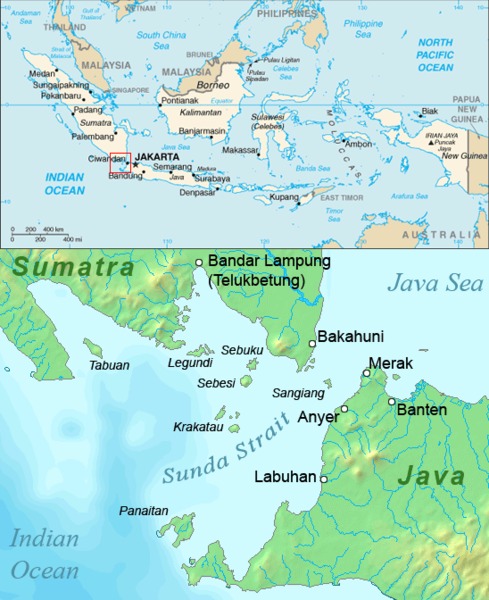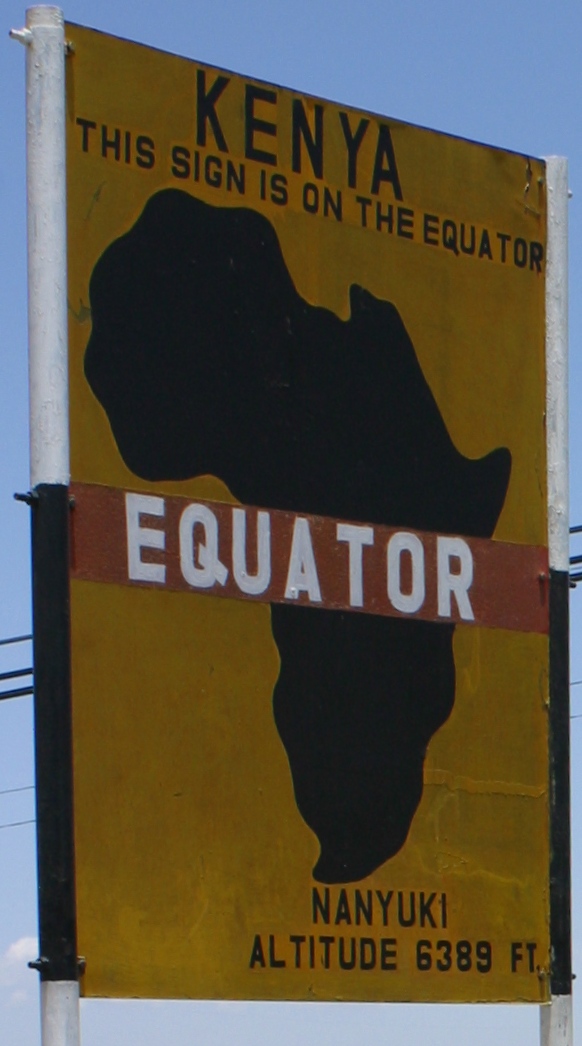|
Legundi
Pulau Legundi (also spelled Lagoendi) is an Indonesian island in the Sunda Strait between Java and Sumatra. It is one of the larger islands in the Strait and lies at the western end of Sumatra's Lampong Bay, in the province of Lampung. Population & Surroundings Although not so far from the mainland, Legundi is sparsely populated with about 80 inhabitants per square kilometer. Due to being lowly populated, agricultural cultivation has never been practiced on a large scale, which has kept intact the island's natural evergreen and semi-deciduous forests. Tabuan Island is to the west. Environment Due to the island's tropical nature and close proximity to the equator The equator is a circle of latitude, about in circumference, that divides Earth into the Northern and Southern hemispheres. It is an imaginary line located at 0 degrees latitude, halfway between the North and South poles. The term can al ..., seasons are not so distinct and temperatures are not so fluctuati ... [...More Info...] [...Related Items...] OR: [Wikipedia] [Google] [Baidu] |
Lampung
Lampung ( Lampung: ), officially the Province of Lampung ( id, Provinsi Lampung) is a province of Indonesia. It is located on the southern tip of the island of Sumatra. It has a short border with the province of Bengkulu to the northwest, and a longer border with the province of South Sumatra to the north. It is the original home of the Lampung people, who speak their own language, and possess their own written script. Its capital is Bandar Lampung. The province covers a land area of 35,376 sq.km and had a population of 7,608,405 at the 2010 census, 9,007,848 at the 2020 census, and 9,081,792 according to the official estimates for mid 2021,with three-quarters of that being descendants of Javanese, Madurese, and Balinese migrants. These migrants came from more densely populated islands, in search of available land, as well as being part of the national government's Indonesian transmigration program, of which Lampung was one of the earliest and most significant transmi ... [...More Info...] [...Related Items...] OR: [Wikipedia] [Google] [Baidu] |
Sunda Strait
The Sunda Strait ( id, Selat Sunda) is the strait between the Indonesian islands of Java and Sumatra. It connects the Java Sea with the Indian Ocean. Etymology The strait takes its name from the Sunda Kingdom, which ruled the western portion of Java (an area covering the present day West Java, Jakarta, Banten, and some of western Central Java) from 669 to around 1579."Sunda Islands". Concise Dictionary of World Place-Names. John Everett-Heath. Oxford University Press 2005. Oxford Reference Online. Oxford University Press. The name also alludes to the Sundanese people native to West Java and Banten, as distinct from the Javanese people, who live mostly in Central and East Java. Geography Extending in a roughly southwest/northeast orientation, with a minimum width of at its northeastern end between Cape Tua on Sumatra and Cape Pujat on Java, the strait is part of the Java Sea. It is essentially triangular in shape, with two large bays on its northern side. It is also very b ... [...More Info...] [...Related Items...] OR: [Wikipedia] [Google] [Baidu] |
Tabuan Island
Tabuan Island ( id, Pulau Tabuan, also spelled Tabuhan or Taboean) is an island of southern Sumatra, under the jurisdiction of Lampung province. It is administered as part of the Cukuh Balak district of Tanggamus Regency. It lies near the middle of the entrance of Semangka Bay, relatively steep and densely wooded. It rises in its south-eastern part to a height of 671m and is said to "appear sharp from S or N. Except on the NE side." Its principal settlement is the village of Sawangbalak, located on the extreme northern tip of the island. The island is noted for its white beaches. About 40 kilometres to the east is Legundi Island. Internet access is unavailable and the telephone access is unstable in this island. A Rp18 billion pier was constructed in 2013 by the Ministry of Transportation A ministry of transport or transportation is a ministry responsible for transportation within a country. It usually is administered by the ''minister for transport''. The term is also so ... [...More Info...] [...Related Items...] OR: [Wikipedia] [Google] [Baidu] |
Sunda Strait Map V3
Sunda may refer to: Europe * Sunda, Faroe Islands India * Sunda (asura), an asura brother of Upasunda * Sunda (clan), a clan (gotra) of Jats in Haryana and Rajasthan, India Southeast Asia * Sundanese (other) ** Sundanese people ** Sundanese language ** Sundanese script ** Sundanese (Unicode block) * Sunda Kingdom, a kingdom that existed in west part of Java island from the 7th century to the 16th century * Kidung Sunda, a literary work that recounts the story of the "Battle of Bubat" between Sundanese and Javanese *Sunda Kelapa, is the old port of Jakarta located on the estuarine of Ciliwung River, the main port of the Sunda Kingdom * Mount Sunda, an ancient extinct supervolcano once exist in Priangan highland during Pleistocene age, the predecessor of Tangkuban Perahu, Burangrang, and Bukit Tunggul volcanoes * Sunda Strait, the strait between Java and Sumatra * Sunda Islands, a group of islands located in Indonesia and Malaysia ** Greater Sunda Islands ** Less ... [...More Info...] [...Related Items...] OR: [Wikipedia] [Google] [Baidu] |
Java
Java (; id, Jawa, ; jv, ꦗꦮ; su, ) is one of the Greater Sunda Islands in Indonesia. It is bordered by the Indian Ocean to the south and the Java Sea to the north. With a population of 151.6 million people, Java is the world's most populous island, home to approximately 56% of the Indonesian population. Indonesia's capital city, Jakarta, is on Java's northwestern coast. Many of the best known events in Indonesian history took place on Java. It was the centre of powerful Hindu-Buddhist empires, the Islamic sultanates, and the core of the colonial Dutch East Indies. Java was also the center of the Indonesian struggle for independence during the 1930s and 1940s. Java dominates Indonesia politically, economically and culturally. Four of Indonesia's eight UNESCO world heritage sites are located in Java: Ujung Kulon National Park, Borobudur Temple, Prambanan Temple, and Sangiran Early Man Site. Formed by volcanic eruptions due to geologic subduction of the Aust ... [...More Info...] [...Related Items...] OR: [Wikipedia] [Google] [Baidu] |
Sumatra
Sumatra is one of the Sunda Islands of western Indonesia. It is the largest island that is fully within Indonesian territory, as well as the sixth-largest island in the world at 473,481 km2 (182,812 mi.2), not including adjacent islands such as the Simeulue, Nias, Mentawai, Enggano, Riau Islands, Bangka Belitung and Krakatoa archipelago. Sumatra is an elongated landmass spanning a diagonal northwest–southeast axis. The Indian Ocean borders the northwest, west, and southwest coasts of Sumatra, with the island chain of Simeulue, Nias, Mentawai, and Enggano off the western coast. In the northeast, the narrow Strait of Malacca separates the island from the Malay Peninsula, which is an extension of the Eurasian continent. In the southeast, the narrow Sunda Strait, containing the Krakatoa Archipelago, separates Sumatra from Java. The northern tip of Sumatra is near the Andaman Islands, while off the southeastern coast lie the islands of Bangka and Belitun ... [...More Info...] [...Related Items...] OR: [Wikipedia] [Google] [Baidu] |
Evergreen
In botany, an evergreen is a plant which has foliage that remains green and functional through more than one growing season. This also pertains to plants that retain their foliage only in warm climates, and contrasts with deciduous plants, which completely lose their foliage during the winter or dry season. Evergreen species There are many different kinds of evergreen plants, both trees and shrubs. Evergreens include: *Most species of conifers (e.g., pine, hemlock, blue spruce, and red cedar), but not all (e.g., larch) * Live oak, holly, and "ancient" gymnosperms such as cycads *Most angiosperms from frost-free climates, and rainforest trees *All Eucalypts * Clubmosses and relatives *Bamboos The Latin binomial term , meaning "always green", refers to the evergreen nature of the plant, for instance :'' Cupressus sempervirens'' (a cypress) :'' Lonicera sempervirens'' (a honeysuckle) :'' Sequoia sempervirens'' (a sequoia) Leaf longevity in evergreen plants varies from ... [...More Info...] [...Related Items...] OR: [Wikipedia] [Google] [Baidu] |
Deciduous
In the fields of horticulture and Botany, the term ''deciduous'' () means "falling off at maturity" and "tending to fall off", in reference to trees and shrubs that seasonally shed leaves, usually in the autumn; to the shedding of petals, after flowering; and to the shedding of ripe fruit. The antonym of ''deciduous'' in the botanical sense is evergreen. Generally, the term "deciduous" means "the dropping of a part that is no longer needed or useful" and the "falling away after its purpose is finished". In plants, it is the result of natural processes. "Deciduous" has a similar meaning when referring to animal parts, such as deciduous antlers in deer, deciduous teeth (baby teeth) in some mammals (including humans); or decidua, the uterine lining that sheds off after birth. Botany In botany and horticulture, deciduous plants, including trees, shrubs and herbaceous perennials, are those that lose all of their leaves for part of the year. This process is called a ... [...More Info...] [...Related Items...] OR: [Wikipedia] [Google] [Baidu] |
Equator
The equator is a circle of latitude, about in circumference, that divides Earth into the Northern and Southern hemispheres. It is an imaginary line located at 0 degrees latitude, halfway between the North and South poles. The term can also be used for any other celestial body that is roughly spherical. In spatial (3D) geometry, as applied in astronomy, the equator of a rotating spheroid (such as a planet) is the parallel (circle of latitude) at which latitude is defined to be 0°. It is an imaginary line on the spheroid, equidistant from its poles, dividing it into northern and southern hemispheres. In other words, it is the intersection of the spheroid with the plane perpendicular to its axis of rotation and midway between its geographical poles. On and near the equator (on Earth), noontime sunlight appears almost directly overhead (no more than about 23° from the zenith) every day, year-round. Consequently, the equator has a rather stable daytime temperature ... [...More Info...] [...Related Items...] OR: [Wikipedia] [Google] [Baidu] |





